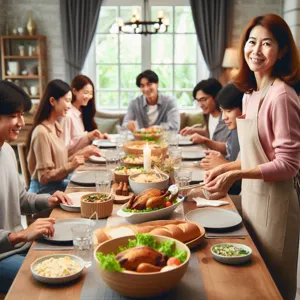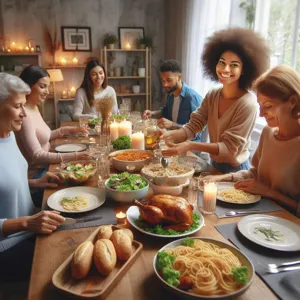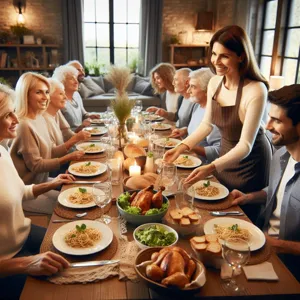When it comes to hosting gatherings, whether it’s a family reunion, holiday celebration, or a casual backyard barbecue, cooking for a crowd can often feel overwhelming.
The pressure to please a diverse group of palates while managing timing, portions, and presentation can turn your culinary dreams into a recipe for stress. But fear not! With the right strategies and a bit of planning, you can transform the daunting task of feeding a flock into a delightful and enjoyable experience. In this blog post, we’ll share essential tips and tricks that will streamline your cooking process, from selecting crowd-pleasing dishes to mastering efficient meal prep techniques. Join us as we explore how to create mouthwatering meals that not only satisfy your guests but also allow you to enjoy the festivities alongside them!
1. Planning Your Menu: Considerations for Cooking for a Crowd

When it comes to cooking for a crowd, careful menu planning is paramount. The first step is to consider the size of your gathering and the dietary preferences of your guests. Are you hosting a casual barbecue for friends, a formal dinner for family, or perhaps a potluck where everyone brings a dish? Each occasion calls for a different approach.
Start by selecting dishes that can be prepared in large quantities without sacrificing flavor or quality. One-pot meals, such as casseroles, stews, or large pasta dishes, can be lifesavers, as they allow for easy preparation and minimal cleanup. Consider incorporating a variety of proteins, grains, and seasonal vegetables to provide a balanced meal that caters to diverse tastes.
Next, remember the importance of timing. Opt for recipes that can be made ahead of time to alleviate stress on the day of the event. Dishes like marinated salads or desserts that benefit from a bit of chilling can often be prepared the night before, freeing you up to focus on last-minute details when your guests arrive.
Don’t forget to account for dietary restrictions! It’s always a good idea to check in with guests beforehand to see if anyone has allergies or specific dietary needs, such as vegetarian or gluten-free options. Including a few inclusive dishes ensures that everyone feels welcome and satisfied.
Lastly, consider the logistics of serving. Buffet-style setups can be effective for larger groups, allowing guests to serve themselves and mingle freely. Think about how you’ll keep food warm or cold, and ensure you have enough serving utensils, plates, and seating for everyone. With thoughtful planning, you’ll create a memorable meal that leaves your guests feeling nourished and appreciated.
2. Essential Kitchen Tools for Large Batch Cooking
When it comes to cooking for a crowd, having the right kitchen tools can make all the difference between a smooth, enjoyable experience and a chaotic scramble. Here are some essential tools that will help you whip up large batches of delicious food with ease.
**1. Extra-Large Pots and Pans:** Investing in oversized pots and pans is crucial for cooking large quantities of soups, stews, or pasta. A heavy-duty stockpot can hold several gallons, ensuring you can prepare enough to feed a crowd without multiple batches. Similarly, large frying pans or griddles make it easier to cook meats and vegetables simultaneously, allowing you to maximize your cooking efficiency.
**2. Commercial-Grade Utensils:** When you’re cooking for many, your standard spatula or spoon may not cut it. Opt for sturdy, commercial-grade utensils that can withstand the rigors of heavy mixing and stirring. Long-handled spoons, large slotted spatulas, and heavy-duty whiskers will help you manage your ingredients effectively.
**3. Food Storage Containers:** After your culinary masterpieces are complete, you’ll need a way to store leftovers or meal prep for the coming days. Invest in a variety of airtight food storage containers in different sizes. Not only will they help you keep your food fresh, but they also make it easy to portion out meals for guests who may want to take some home.
**4. Mixing Bowls:** Large, deep mixing bowls are essential for tossing salads, marinating meats, or combining ingredients. Choose bowls made from durable materials such as stainless steel or glass that can handle both hot and cold ingredients.
**5. Slow Cookers and Instant Pots:** These versatile appliances are lifesavers when cooking for a crowd. Slow cookers are perfect for making big batches of chili, pulled pork, or hearty casseroles, allowing you to set it and forget it. Meanwhile, Instant Pots can speed up cooking time significantly, enabling you to prepare rice, beans, or even tough cuts of meat quickly and efficiently.
**6. Serving Dishes and Utensils:** Once your meal is ready, you’ll want to present it in style. Large serving platters, bowls, and trays will help you display your culinary creations beautifully. Don’t forget to have plenty of serving utensils on hand to make it easy for guests to help themselves.
By equipping your kitchen with these essential tools, you’ll streamline your cooking process and be well on your way to feeding your flock with confidence and ease. With the right tools in hand, large batch cooking can become a fun and fulfilling endeavor, allowing you to focus on what truly matters—enjoying the time spent with friends and family around the table.
3. Budgeting Tips: How to Feed a Crowd Without Breaking the Bank

Feeding a crowd can seem daunting, especially when you’re watching your budget. However, with some strategic planning and creativity, you can serve delicious meals that satisfy everyone without straining your wallet. Here are some effective budgeting tips to ensure your next gathering is both enjoyable and economical.
First, consider the power of bulk buying. When preparing meals for a large group, purchasing ingredients in bulk can significantly reduce costs. Look for wholesale clubs or local markets that offer discounts on larger quantities. Staples such as rice, pasta, beans, and frozen vegetables often come at lower prices when bought in bulk. Not only do these ingredients stretch your budget, but they also serve as versatile bases for a variety of dishes.
Next, embrace the beauty of seasonal produce. Shopping for fruits and vegetables that are in season not only enhances the freshness of your meals but also lowers your grocery bill. Seasonal ingredients are usually more abundant and thus less expensive. Incorporate these vibrant veggies into salads, sides, or main dishes to add color and nutrition while keeping costs down.
Another smart strategy is to plan a potluck-style meal. Encourage your guests to bring a dish to share, which not only lightens your cooking load but also adds variety to the menu. This communal approach fosters a sense of togetherness and allows everyone to contribute their culinary talents, while also minimizing food expenses.
Lastly, don’t forget about meal planning and portion control. Create a clear menu that outlines what you’ll serve and how much of each dish is necessary. Over-preparing can lead to wasted food, which is a drain on your budget. By estimating portion sizes, you can ensure that everyone is satisfied without excessive leftovers.
With these budgeting tips in your cooking arsenal, you can confidently host a crowd-pleasing event that leaves your guests delighted and your finances intact. Remember, feeding a group doesn’t have to be synonymous with overspending; with clever planning and creativity, you can create memorable meals that bring everyone together.
4. Choosing Dishes: Best Recipes for Large Groups
When it comes to cooking for a crowd, selecting the right dishes can make all the difference between a delightful gathering and a stressful kitchen experience. The key is to choose recipes that are not only crowd-pleasers but also easy to prepare in large quantities, allowing you to spend less time cooking and more time enjoying the company of your guests.
Start with hearty casseroles and one-pot meals, which can often be prepared in advance and simply popped into the oven when it’s time to serve. Classics like lasagna or a creamy vegetable gratin can feed many and offer a comforting touch that everyone loves. For a more interactive dining experience, consider setting up a taco bar or a pasta station. This allows guests to personalize their meals, which adds a fun element to the gathering and reduces your workload at the same time.
Don’t overlook the power of salads! A vibrant, big-batch salad can complement any meal and can be made ahead of time. Think about options like a quinoa salad with roasted vegetables or a classic Greek salad; both are nutritious and can be easily scaled up. Additionally, consider making a variety of dips or appetizers that guests can enjoy while mingling. Dishes like a large charcuterie board or a platter of assorted dips paired with fresh vegetables and pita chips create an inviting atmosphere and require minimal effort on your part.
Lastly, embrace the slow cooker or Instant Pot for dishes that require minimal supervision. From tender pulled pork to fragrant stews, these appliances can help you manage your time efficiently while ensuring that everyone is satisfied and well-fed. By thoughtfully selecting dishes that are simple to prepare, you can focus on what truly matters—creating memorable moments with friends and family around the table.
5. Meal Prep Strategies: Organizing Your Time Efficiently when cooking for a crowd

When cooking for a crowd, organization is your best ally. Meal prep strategies can make all the difference between a chaotic kitchen and a smooth, enjoyable cooking experience. The key lies in efficient time management and forward planning.
Start by creating a detailed menu that outlines every dish you plan to serve. This not only helps you visualize your meal but also allows you to identify overlapping ingredients, which can simplify shopping and prep. Once your menu is set, make a comprehensive grocery list to ensure you have everything you need before the big cooking day.
Next, dedicate some time to prep work in advance. Chopping vegetables, marinating meats, and even pre-cooking certain components can save you precious time on the day of your event. Consider batch cooking staples like rice, pasta, or sauces that can be refrigerated and quickly reheated. Not only does this lighten your workload, but it also enhances flavors as they have time to meld together.
Another effective strategy is to employ a timeline. Break down your cooking tasks by hours, prioritizing dishes that take longer to prepare. For example, if you’re roasting a large piece of meat, factor in not just the cooking time but also the resting time it needs before serving. By working backward from your meal time, you’ll ensure that everything is ready to go when your guests arrive.
Lastly, don’t underestimate the power of teamwork. If you have willing family members or friends, enlist their help. Assign specific tasks to each person, turning your cooking session into a collaborative effort. This not only speeds up the process but also makes it more enjoyable, allowing you to bond with your loved ones as you create a feast together.
With these meal prep strategies in place, you’ll transform the daunting task of cooking for a crowd into a well-orchestrated event, leaving you free to focus on what really matters—enjoying the time spent with your guests.
6. Cooking Methods: Oven, Slow Cooker, and More
When it comes to cooking for a crowd, the methods you choose can significantly impact both the ease of preparation and the quality of the food. Understanding the strengths and weaknesses of various cooking techniques is essential for a successful gathering.
**Oven Cooking**: The oven is a versatile powerhouse when feeding a large group. Roasting meats, baking casseroles, or even preparing sheet pan dinners can help you feed many with minimal fuss. The beauty of oven cooking is that it allows you to prepare multiple dishes at once, especially if you invest in a couple of robust baking sheets or roasting pans. While the oven handles the cooking, you can focus on side dishes or setting the table, maximizing your efficiency. Just be sure to keep an eye on cooking times, as larger portions may require adjustments.
**Slow Cooker**: If you’re looking for a method that allows for hands-off cooking, a slow cooker is your best friend. Perfect for stews, soups, and even pulled meats, a slow cooker can simmer flavors together while you attend to other tasks. Simply toss in your ingredients, set the timer, and let it work its magic. This method not only ensures tender, flavorful dishes but also frees you up to socialize with your guests or prepare other elements of the meal. Plus, slow cookers are often large enough to provide generous servings, making them ideal for a crowd.
**Grilling**: Don’t overlook the grill, especially during warmer months! Grilling can impart a delicious smoky flavor to meats and vegetables and can be a fun way to serve food in a casual outdoor setting. Whether you opt for burgers, skewers, or grilled vegetables, this method keeps the kitchen cool and allows you to prepare food while mingling with your guests. Just remember to plan for cooking times and ensure you have enough grill space for everything you intend to serve.
**Stovetop Cooking**: For dishes that require quick cooking, such as pasta or stir-fries, the stovetop is an efficient option. It allows for flexibility and quick adjustments, letting you whip up large portions in a fraction of the time. Utilizing multiple burners can also help you multitask, making it easier to coordinate the timing of different dishes.
Incorporating a mix of these cooking methods can alleviate the stress of preparing food for a crowd. Each method offers its set of benefits, and by balancing them, you can create a varied and delicious menu that delights your guests and keeps your stress levels in check. With a little planning and creativity, you’ll find that cooking for a crowd can be an enjoyable experience rather than a daunting task.
7. Keeping Food Safe: Essential Food Safety Guidelines

When cooking for a crowd, ensuring food safety should be at the forefront of your planning. With larger quantities and diverse dishes, the risk of foodborne illness can increase if proper precautions aren’t taken. Here are some essential food safety guidelines to help keep your meal both delicious and safe for everyone.
First and foremost, maintain cleanliness in your cooking area. Start by washing your hands thoroughly with soap and warm water for at least 20 seconds before handling any food. This simple step is crucial in preventing the spread of bacteria. Make sure all surfaces, utensils, and cutting boards are sanitized before you begin prepping your ingredients. Consider using separate cutting boards for raw meats and vegetables to avoid cross-contamination.
When it comes to storing ingredients, keep perishable items refrigerated until you’re ready to use them. The USDA recommends that food be kept out of the “danger zone” — between 40°F and 140°F — where bacteria can multiply rapidly. If your event spans several hours, consider using chafing dishes or slow cookers to keep hot foods at safe temperatures, and ensure cold dishes are served on ice or in chilled serving platters.
Another vital guideline is to monitor your cooking temperatures. Use a food thermometer to check that meats are cooked to their recommended internal temperatures: poultry should reach 165°F, ground meats 160°F, and whole cuts of beef, pork, and lamb should hit at least 145°F. This not only guarantees that your food is cooked safely but also enhances the flavor and texture of your dishes.
Lastly, be mindful of leftovers. If your gathering leaves you with uneaten food, refrigerate it within two hours to prevent bacterial growth. Store leftovers in clear, airtight containers and label them with the date to keep track of freshness. Serve only what you think will be consumed to minimize waste and ensure that everyone enjoys safe, tasty food.
By adhering to these essential food safety guidelines, you can confidently prepare a delightful meal for your guests, allowing them to focus on enjoying the occasion rather than worrying about their health. Happy cooking!
8. Setting Up Your Cooking Space: Maximizing Efficiency
When it comes to cooking for a crowd, the key to a smooth and enjoyable experience lies in how well you set up your cooking space. Maximizing efficiency is not just about having the right tools at your disposal, but also about creating a well-organized environment that allows you to move seamlessly from one task to the next.
Start by decluttering your kitchen counters and ensuring all necessary tools and ingredients are within arm’s reach. Create dedicated zones for different tasks—prep, cooking, plating, and serving. For instance, designate a large surface area for chopping vegetables and assembling dishes, while keeping your pots, pans, and utensils nearby for easy access during cooking.
Consider the flow of your kitchen. Position your stovetop, oven, and sink in a way that allows you to move fluidly between them without unnecessary backtracking. If you have a helper or two, assign specific tasks to each person, ensuring that everyone knows their role and the layout of the kitchen. This not only streamlines the cooking process but also minimizes confusion and maximizes productivity.
Don’t forget about the importance of lighting and ventilation. A well-lit kitchen enhances visibility, making it easier to see what you’re doing, while good ventilation helps keep the air fresh and free of cooking odors. If you can, open a window or turn on a fan to create a comfortable cooking environment.
Finally, embrace the use of time-saving gadgets like slow cookers, pressure cookers, or food processors. These tools can significantly cut down on preparation time and allow you to focus on other aspects of your meal. By setting up your cooking space with intention, you’ll not only enhance your efficiency but also reduce stress, making the experience of cooking for a crowd an enjoyable and rewarding one.
9. Delegating Responsibilities: Enlist Help from Friends and Family
Cooking for a crowd can be a daunting task, but it doesn’t have to be a solo endeavor. One of the most effective strategies for easing the burden and enhancing the experience is to delegate responsibilities. Enlisting friends and family not only lightens your load but also transforms the event into a collaborative and enjoyable gathering.
Start by assessing the tasks that need to be accomplished—meal prep, cooking, setting the table, and cleaning up afterward. Once you have a clear picture, reach out to your circle and assign specific responsibilities based on each person’s strengths and preferences. Perhaps your friend is a whiz at chopping vegetables, while another excels at baking desserts. By tapping into these skills, you not only ensure a smoother workflow but also allow everyone to contribute their unique talents to the meal.
Communicate clearly about what you need help with and establish a timeline for when each task should be completed. A shared digital document or group chat can be an effective way to coordinate efforts and keep everyone on the same page. This approach fosters a sense of teamwork and camaraderie, turning the cooking process into a fun and social experience rather than a stress-filled chore.
Moreover, consider making it a potluck-style gathering where each guest brings a dish. This not only eases your burden but also adds variety to the meal, allowing everyone to showcase their culinary flair. Plus, the excitement of tasting different dishes can become a highlight of the gathering, sparking conversations and connections among guests.
By involving friends and family in the cooking process, you not only lighten your workload but also create lasting memories. The laughter shared over chopping vegetables, the friendly debates over the best way to season a dish, and the collective satisfaction of a well-prepared meal will make the effort worthwhile. So, roll up your sleeves, gather your crew, and enjoy the delightful chaos that comes with cooking for a crowd!
10. Serving Styles: Buffet vs. Plated Meals
When it comes to feeding a crowd, the style of service can significantly impact both the dining experience and the overall atmosphere of your event. The two most popular serving styles—buffet and plated meals—each have their unique advantages and considerations, so it’s essential to weigh them carefully to find what works best for your gathering.
**Buffet Style:** A buffet can create a relaxed and informal vibe, allowing guests to mingle and serve themselves at their own pace. This style is particularly advantageous for larger gatherings, as it can handle a wide variety of dishes and dietary preferences. Imagine a long table adorned with colorful platters of food, where guests can choose from an array of options, from savory roasted meats to vibrant vegetarian dishes and mouthwatering sides. Buffets also reduce the need for extensive staffing, as fewer servers are needed to manage the flow of food. Plus, the visual appeal of beautifully arranged dishes can be a feast for the eyes, tantalizing guests before they even take their first bite.
**Plated Meals:** On the other hand, plated meals offer a more formal dining experience, where each guest is served a curated selection of dishes at their seat. This approach can create an elegant atmosphere, perfect for weddings, corporate events, or milestone celebrations. Plated meals allow for precise portion control and can make it easier to accommodate food allergies or specific dietary restrictions. With a well-chosen menu, guests can enjoy a thoughtfully crafted dining experience with beautifully plated dishes that showcase your culinary skills. However, it typically requires more staff for serving and can demand more time to execute, especially during peak meal times.
Ultimately, the choice between buffet and plated meals comes down to the type of gathering you’re hosting, the atmosphere you wish to create, and the logistics of serving a crowd. Consider your audience, the space you have available, and the level of formality you desire. Whichever serving style you choose, both can be executed seamlessly with a bit of planning, ensuring your guests leave satisfied and eager for the next gathering!
11. Tips for Scaling Recipes: Adjusting Ingredient Quantities
Cooking for a crowd can be a daunting task, especially when it comes to scaling recipes. However, with the right approach, you can adjust ingredient quantities without sacrificing flavor or texture. Here are some essential tips to help you navigate this culinary challenge with ease.
**1. Understand the Recipe**: Before you start scaling, take the time to understand the original recipe. Note the number of servings it yields and identify the key ingredients. This will help you determine how much to multiply each component based on the number of guests you expect.
**2. Use the Right Ratios**: While some ingredients can be scaled linearly, others require a bit more finesse. For instance, spices and seasonings often need to be adjusted to taste rather than simply multiplied. A good rule of thumb is to start with 1.5 times the original amount and taste as you go, allowing yourself to fine-tune the flavor.
**3. Consider Cooking Times**: When increasing the quantity of a dish, remember that cooking times may vary. Larger batches can take longer to cook, especially in the case of baked goods or casseroles. Make sure to adjust your cooking time accordingly and keep an eye on doneness to avoid overcooking or undercooking.
**4. Invest in Quality Equipment**: Scaling up often means you’ll need larger pots, pans, and mixing bowls. Investing in high-quality equipment can make a significant difference in your cooking experience. Additionally, larger appliances like slow cookers or roasters can be incredibly helpful for feeding a crowd.
**5. Make Ahead When Possible**: Some dishes, like stews or soups, often taste better the next day as the flavors meld. Whenever possible, prepare these dishes in advance to save time on the day of your gathering. This also allows you to focus on other elements of your meal, such as sides or desserts.
**6. Keep It Simple**: When cooking for a large group, it can be tempting to impress with intricate dishes. However, simplicity is your friend. Choose recipes that require minimal ingredients and steps, allowing you to manage your time and energy more effectively.
By following these tips for scaling recipes, you’ll find that cooking for a crowd can be a rewarding experience rather than a stressful one. With careful planning and preparation, you can create delicious meals that will leave your guests raving and eager for the next gathering.
12. Creative Leftover Ideas: Making the Most of Extra Food
When cooking for a crowd, it’s not uncommon to find yourself with an abundance of leftovers. Rather than letting that extra food go to waste, why not transform those remnants into delicious new meals? Creative leftover ideas not only help you reduce waste but also save you time and money in the kitchen.
Start by repurposing your main dishes into entirely new creations. For instance, leftover roasted chicken can be shredded and tossed into a hearty soup, added to a vibrant salad, or transformed into flavorful tacos with just a few fresh ingredients. Similarly, if you’ve prepared a large batch of pasta, consider turning it into a baked pasta dish or a refreshing pasta salad the next day.
Don’t overlook the power of a good frittata! Leftover vegetables can be whisked into eggs for a hearty breakfast or brunch option that’s both satisfying and quick to prepare. You can also blend leftover grains, like rice or quinoa, with some sautéed vegetables and a protein of your choice to create a scrumptious grain bowl, ideal for lunch.
For those sweet leftovers, consider making a decadent bread pudding with leftover bread or whipping up a smoothie with any overripe fruits. Even desserts can take on a new life; crumbled cake can become a delicious parfait layered with yogurt and fresh berries, or use extra frosting to top off cookies for a delightful treat.
By thinking outside the box and embracing your creativity, you can turn your leftover food into new culinary adventures, ensuring that nothing goes to waste while delighting your family and friends with fresh flavors. Transforming your surplus into exciting meals not only adds variety to your menu but also keeps the joy of cooking alive long after the initial gathering has ended.
13. Special Dietary Needs: Accommodating Allergies and Preferences
When cooking for a crowd, accommodating special dietary needs is not just a thoughtful gesture—it’s essential for creating an inclusive dining experience. In today’s diverse culinary landscape, guests may arrive with a range of dietary restrictions, from common allergies like gluten and nuts to lifestyle choices such as vegetarianism or veganism. Ignoring these needs can lead to discomfort, disappointment, or even health risks, so addressing them in advance will elevate your gathering.
Start by communicating with your guests ahead of time. A simple RSVP request asking about dietary restrictions can provide valuable insight. Create a checklist of common allergens—like dairy, eggs, soy, and shellfish—and ask guests to indicate any they may have. This proactive approach not only helps you plan but also shows your guests that you care about their well-being.
Once you have this information, it’s time to get creative! Consider preparing a few versatile dishes that can be easily modified to accommodate different preferences. For example, a hearty pasta salad can be made with gluten-free pasta and served with a variety of dressings on the side, allowing gluten-sensitive guests to enjoy the meal without worry. Offering a selection of toppings for a baked potato bar can delight both vegans and meat-eaters alike, providing options like dairy-free sour cream, sautéed vegetables, and crispy bacon.
Another key tip is to label your dishes clearly. Use small signs to indicate which foods are vegan, vegetarian, gluten-free, or contain common allergens. This not only assists guests in making informed choices but also sparks conversation around the food you’ve prepared.
Finally, don’t forget about dessert! Many traditional sweets can easily be adapted to suit dietary needs. Think flourless chocolate cake for gluten-free guests or fruit sorbet for a refreshing vegan option.
By taking the time to accommodate special dietary needs, you not only ensure that all your guests feel included but also showcase your culinary skills and creativity. A well-planned menu that considers everyone’s preferences can transform a simple gathering into a memorable feast where everyone leaves satisfied.
14. Presentation Tips: Making Your Spread Visually Appealing
When it comes to cooking for a crowd, the adage “we eat with our eyes first” couldn’t be more accurate. An enticing presentation can elevate your meal from ordinary to extraordinary, making it not just a feast for the stomach, but also a delight for the senses. Here are some essential presentation tips to ensure your spread looks as delicious as it tastes.
**Color, Color, Color**: Incorporate a vibrant array of colors into your dishes. Fresh herbs, roasted vegetables, and colorful sauces can all add visual interest to your table. Consider the color wheel when planning your menu; complementary colors can enhance the overall aesthetic. For instance, pairing bright green asparagus with rich purple eggplant creates a stunning visual contrast.
**Layering and Heights**: Avoid a flat presentation by layering your dishes and varying the heights on the table. Use cake stands, wooden boards, or tiered trays to create levels. For example, stack your appetizers on a multi-tiered platter or arrange salads in clear bowls to showcase the fresh ingredients. This not only adds dimension but also encourages guests to explore each dish.
**Garnish Wisely**: A thoughtful garnish can transform a simple dish into a culinary masterpiece. Fresh herbs, edible flowers, or a sprinkle of microgreens can add both flavor and visual appeal. Just be sure that your garnishes are edible and complement the dish in taste. For instance, a sprig of rosemary on roasted potatoes or a sprinkle of pomegranate seeds over a salad can provide that final touch that makes your dish pop.
**Serving Ware Matters**: The right serving dishes can make all the difference. Opt for platters and bowls that enhance the colors and textures of your food. White or light-colored dishes often serve to highlight vibrant foods, while rustic wooden boards can lend a homey feel to a charcuterie spread. Additionally, consider using clear glass containers for salads or desserts, allowing guests to see the beautiful layers within.
**Create a Narrative**: Arrange your spread in a way that tells a story. Group similar items together—think a Mediterranean section with hummus, olives, and pita, or a taco bar with all the fixings. This not only guides your guests in choosing their meals but also invites them to engage with the food, sparking conversations and excitement around the various offerings.
By attending to the visual elements of your meal, you create an inviting atmosphere that enhances the dining experience. Remember, a well-presented spread not only showcases your culinary skills but also reflects the care and effort you’ve put into feeding your flock. So, as you prepare for your gathering, take the time to arrange your dishes thoughtfully—your guests will appreciate the extra touch, and your meal will be remembered long after the last bite is taken.
15. Final Thoughts: Enjoying the Process and the Company of the crowd
Cooking for a crowd can seem like a daunting task, but it’s essential to remember that the heart of any gathering lies in the joy of sharing food and creating memories together. As you prepare to feed a group, take a moment to shift your focus from the stress of the kitchen to the camaraderie that surrounds the table. Embrace the process as an opportunity to connect with your loved ones, whether it’s through laughter over a shared recipe or the excitement of trying something new.
In the midst of chopping, stirring, and plating, allow yourself to savor each moment. Play your favorite music in the background, invite a friend to help, or share stories with family members as you cook. These interactions can turn the preparation into an enjoyable experience rather than a chore. Remember, it’s perfectly okay if not everything goes according to plan. Sometimes, the most memorable meals come from unexpected twists, whether it’s a recipe that didn’t turn out quite right or a last-minute ingredient swap.
As the food is served and the laughter fills the air, take a step back and appreciate the fruits of your labor. Watch as your friends and family enjoy the meal you’ve lovingly prepared. Engage in conversations, reminisce about past gatherings, and create new stories to carry forward. The key to cooking for a crowd is not just about the food but about fostering connections and celebrating togetherness. So, let go of perfection, embrace the delightful chaos, and relish in the company of those who gather around your table. After all, it’s these moments of joy and connection that make the effort truly worthwhile.
We hope you found our tips for cooking for a crowd both inspiring and practical! Feeding a large group can seem daunting, but with the right planning and strategies, you can create a delicious and memorable meal that brings everyone together. From choosing the right recipes and prepping in advance to utilizing your kitchen tools efficiently, these tips will help you navigate the challenges of large-scale cooking with confidence. So gather your ingredients, invite your friends or family, and let the joy of cooking for a crowd transform your next gathering into a delightful feast. Remember, the heart of any great meal lies in the love and care you put into it—happy cooking!






